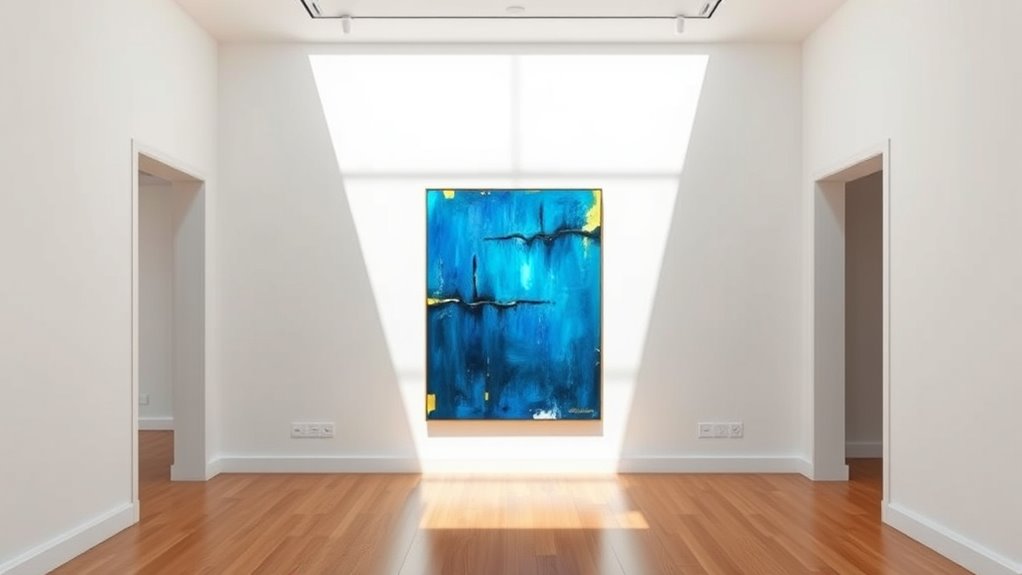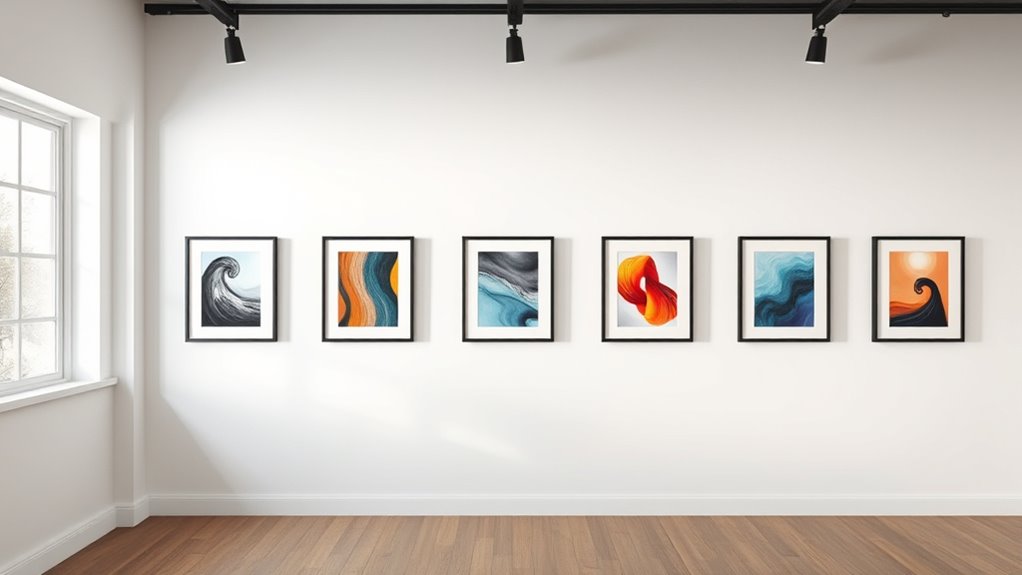To hang art at the right height, aim for the center of your artwork to be about 57 to 60 inches from the floor, ensuring comfortable viewing. Adjust based on your space, artwork size, and placement above furniture—typically 4 to 6 inches above the piece. Keep an eye on visual balance and harmony with your decor. Want to perfect your art display? Explore more tips to achieve flawless hanging every time.
Key Takeaways
- Aim for the artwork’s center to be approximately 57-60 inches from the floor for optimal eye level.
- Adjust height based on artwork size and shape to maintain visual balance.
- Hang art 4-6 inches above furniture like sofas or sideboards for cohesive spacing.
- Consider room layout and decor to ensure the art complements other elements.
- Use measurements as a guide, then refine placement based on visual harmony and personal preference.

Have you ever wondered if your artwork is hanging at the perfect height? It’s a common question, and the answer isn’t always straightforward. The key is understanding that the ideal height depends on the space, the artwork itself, and how you want it to interact with the viewer. When you hang art too high, it can feel disconnected from the room, and if it’s too low, it might look out of place or be easily bumped. Striking the right balance makes all the difference.
Start by considering the eye level of the average person. Typically, this is around 57 to 60 inches from the floor to the center of the artwork. This rule works well for most homes and galleries because it ensures the piece is comfortably visible without forcing viewers to look up or down. When you measure, find the midpoint of your artwork and mark that spot. Then, measure from the floor to that mark, and adjust accordingly. This simple step helps keep your art at a consistent and pleasing height.
Aim for the center of artwork around 57-60 inches from the floor for optimal viewing.
However, don’t forget to account for the size and shape of the piece. Larger works can be hung slightly lower or higher depending on their dimensions. For example, if you’re hanging a wide, horizontal piece, you might want to position it so that the center aligns with your eye level or slightly below, to make it feel balanced within the space. Conversely, small or vertically oriented pieces can be hung a bit higher to avoid feeling cramped or disconnected from furniture or other decor.
The furniture around your artwork also influences the ideal height. Art positioned above a sofa or a sideboard should be hung so that the bottom of the frame is about 4 to 6 inches above the furniture. This creates a visual connection without making the piece seem disconnected or overly cramped. When you’re hanging art above a table, mantle, or console, aim for a similar rule of thumb: about 4 inches from the top of the furniture to the bottom of the frame.
Additionally, considering visual harmony can help you determine the best height, ensuring the artwork complements other elements in the room. Lastly, trust your instincts. If something feels off, don’t be afraid to tweak the height. Stand back, look at the piece from different angles, and see how it interacts with the room. Remember, hanging art at the right height isn’t just about rules; it’s about creating harmony and making sure your artwork complements the space and your style.
Frequently Asked Questions
How Do I Measure Art for Uneven Walls?
To measure art for uneven walls, start by identifying a consistent reference point, like eye level. Use a painter’s tape or a level to mark the desired height on the wall, then measure from that mark to the top of your frame. Adjust for any wall imperfections by using spacers or shims behind the frame if needed. This way, your art will hang straight and look balanced, no matter the wall’s irregularities.
What Tools Are Best for Precise Hanging?
You need a level, a tape measure, and a pencil for precise hanging. The level guarantees your art stays straight, while the tape measure helps you find the perfect height. Use the pencil to mark your spots accurately. For the most precision, consider a laser level—it projects straight lines effortlessly and works well on uneven walls. These tools make hanging art easier and ensure everything looks perfectly aligned.
How Do I Hang Art in High or Low Ceilings?
When hanging art in rooms with high or low ceilings, you should adjust the placement to maintain visual balance. For high ceilings, hang your art slightly lower than the standard eye level to create a cozy feel. In rooms with low ceilings, position artwork higher to create an illusion of space. Use a measuring tape and a level to guarantee precise placement, and consider grouping smaller pieces to fill larger wall spaces effectively.
Can I Mix Different Frame Styles at Different Heights?
Yes, you can definitely mix different frame styles at varying heights. Interestingly, a study shows that eclectic art arrangements boost visual interest and creativity in a space. To pull this off, vary the frame styles intentionally, and hang them at different heights to create a dynamic gallery wall. Keep the spacing balanced, and focus on unifying elements like color or theme to ensure a cohesive look.
What’s the Best Method for Hanging Heavy Artwork?
You should use heavy-duty picture hooks or wall anchors rated for the artwork’s weight. First, locate wall studs using a stud finder for added support. Drill pilot holes if needed, then secure the hooks or mounting hardware tightly into the wall. Always double-check the weight capacity of your hardware. This guarantees your heavy artwork stays securely in place, preventing accidents or damage.
Conclusion
Now that you know the secrets to hanging art at just the right height, your walls will tell stories that truly shine. Think of your artwork as the heartbeat of your space—when hung perfectly, it flows effortlessly and breathes life into your room. So, grab that tape measure, trust your eye, and hang with confidence. Your walls are ready to dance with beauty, turning every glance into a moment of admiration.









